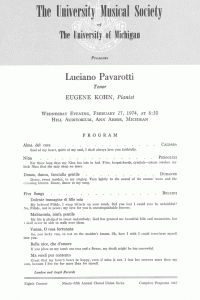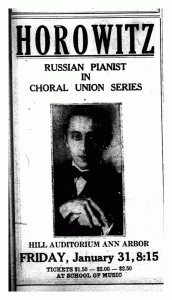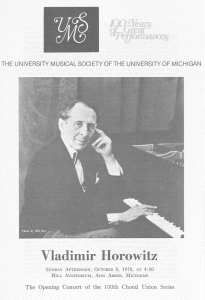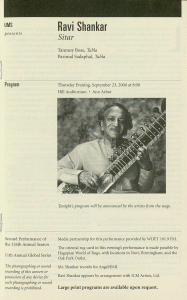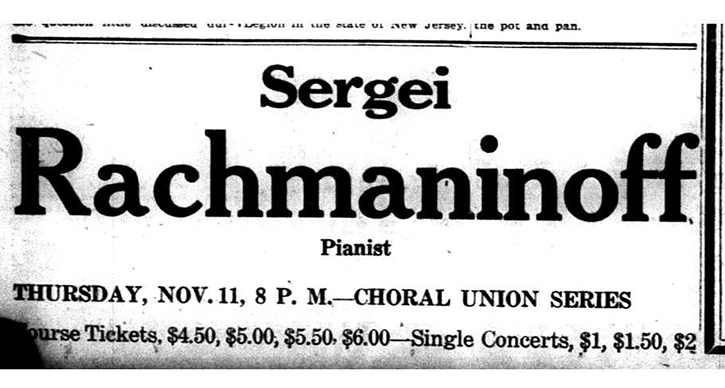This Day in UMS: Luciano Pavarotti
Editor’s Note: “This day in UMS History” is an occasional series of vignettes drawn from UMS’s historical archive. If you have a personal story or particular memory from attending the performance featured here, we’d love to hear from you in the comments.
February 27, 1974: Luciano Pavarotti
Photo: Program for the recital.
Luciano Pavarotti’s 1974 recital in Ann Arbor was only his second of his career. At lunch with Carol Wargelin, former UMS artistic administrator, he ordered two steak dinners and devoured both as she made notes on changes in his program for the evening.
Looking up from her notes, she caught him stealing ice cream from her dessert plate. Playing to his undeniable charm, she exacted repayment by asking him to sing a favorite aria. He sang it to her, right there, sotto voice.
This Day in UMS: Vladimir Horowitz
Editor’s Note: “This day in UMS History” is an occasional series of vignettes drawn from UMS’s historical archive. If you have a personal story or particular memory from attending the performance featured here, we’d love to hear from you in the comments.
January 31, 1930: Vladimir Horowitz in Hill Auditorium
Photos: (Left) 1930 advertisement in the Ann Arbor News (Ann Arbor News Ann Archives, Arbor District Library). (Right) Program from 1978 performance.
The great Russian pianist Vladimir Horowitz first performed in Ann Arbor on January 31, 1930, and then on another 8 occasions before 1953, when he began his long “intermission” from the concert stage. For music lovers, those years only enhanced his legend, and his return to stage in the 1970s caused a sensation.
For the inaugural concert of the hundredth season of UMS concerts in 1978, no artist could have been more fitting. Adding to the centennial pride of the local audience, the pianist was celebrating his fiftieth anniversary of his own American debut. This 1978 performance, before an enraptured audience, featured a program of works of Chopin, Rachmaninoff, and an enraptured audience found it hard to let Horowitz go, calling him back for four encores.
This Day in UMS: Ravi Shankar
Editor’s Note: “This day in UMS History” is an occasional series of vignettes drawn from UMS’s historical archive. If you have a personal story or particular memory from attending the performance featured here, we’d love to hear from you in the comments.
December 11: Anniversary of Ravi Shankar’s Death
Legendary virtuoso sitarist, composer, teacher, and writer, Ravi Shankar was India’s most esteemed musical Ambassador and a singular phenomenon in the classical music worlds of both East and West. A prolific composer, he composed numerous traditional ragas and talas, as well as many works involving western collaborations, including two concertos for sitar and orchestra for violinist Yehudi Mehunin and collaboration with Philip Glass, including the multi-artist work Orion, which opened the 2004 Cultural Olympiad in Greece. The New York Times called him the “Sitarist who introduced Indian Music to the West.”
UMS first had the honor of presenting Ravi Shankar in April 1996 in Rackham Auditorium. The program pictured above is from a solo performance in Hill Auditorium in September 2004.
This Day in UMS: Sergei Rachmaninoff
Editor’s Note: “This day in UMS History” is an occasional series of vignettes drawn from UMS’s historical archive. If you have a personal story or particular memory from attending the performance featured here, we’d love to hear from you in the comments.
November 11, 1920: Sergei Rachmaninoff in UMS Choral Union Series
Photo: Advertisement in the Ann Arbor News (Ann Arbor News Ann Archives, Arbor District Library).
The celebrated Russian pianist and composer Sergei Rachmaninoff performed solo in Hill Auditorium as part of the 42nd season of the Choral Union Series on November 11, 1920. He opened his recital with a performance of “The Star Spangled Banner,” during which the entire audience remained sanding. The remainder of his program consisted of six pieces: Beethoven’s Sonate Opus 90 in e minor, Mendelssohn’s Six Songs Without Words, Chopin’s Ballade, Valse, and Barcarolle, Grieg’s On the Mountains, Liszt’s Rhapsodie Espagnol, and his own Prelude, C-sharp minor Etude-Tableaux, Opus 33.
His masterful tone, unique personality, and flawless technique delighted a sold out Hill Auditorium, as audience members were in awe of his interpretation of his own works and how he portrayed the sorrow and fatalism of his own Russia. Sergei Rachmaninoff returned to Ann Arbor and Hill Auditorium for a second time in 1939, performing another solo recital as part of the 61st Choral Union Series.
This Day in UMS: Enrico Caruso
Editor’s Note: “This day in UMS History” is an occasional series of vignettes drawn from UMS’s historical archive. If you have a personal story or particular memory from attending the performance featured here, we’d love to hear from you in the comments.
October 19, 1918: Enrico Caruso with Nina Morgana, soprano, and Elias Breeskin, violinist
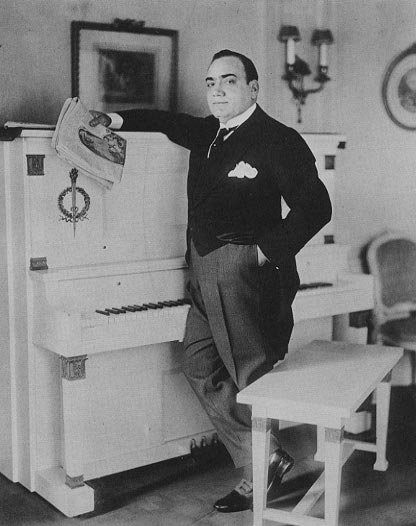
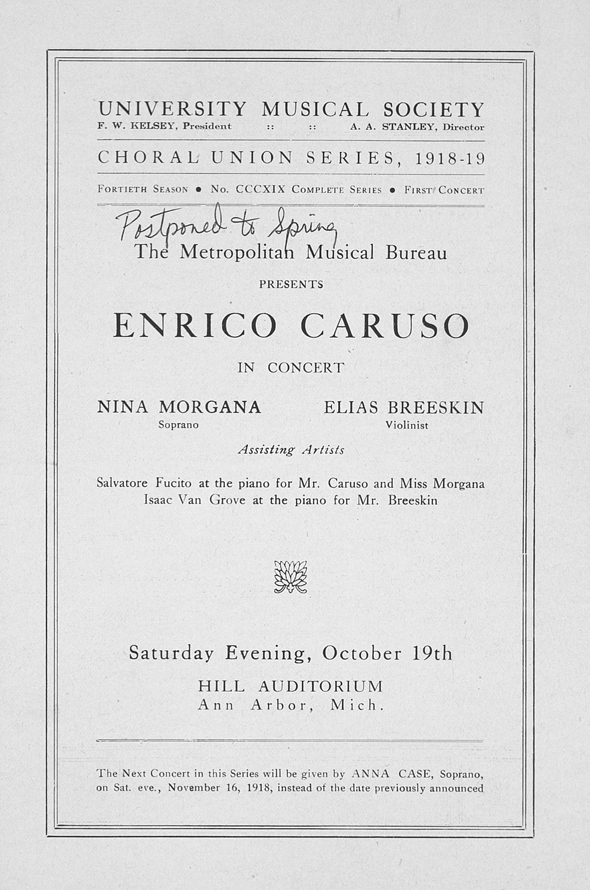
Photo: (Left) Enrico Caruso with his piano. (Right) UMS concert program.
Near the end of his 25-year career, Italian tenor Enrico Caruso was scheduled to sing selections from several operas during his performance alongside soprano Nina Morgana and violinist Elias Breeskin at Hill Auditorium in October of 1918. The performance was postponed until March of the following year due to the Spanish Flu pandemic.
The first singer to sell over a million copies of his recording, Caruso charmed audiences the world over as the first global media celebrity due to innovations in radio and television technology. His performance at UMS included an extensive repertoire of ten songs, all noted for their difficulty and beauty, including Souvenir de Moscow, Celste Aida, Una Furtiva Lagrima, Vesti La Giubba, and concluding with The Star Spangled Banner.


